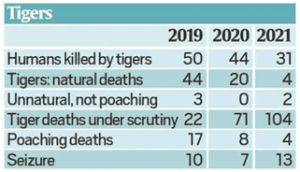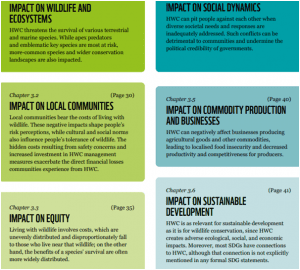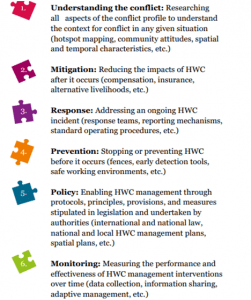THE CONTEXT: Human-wildlife conflict refers to encounters between humans and wildlife that lead to negative results, such as loss of property, livelihoods, and even life. Recently a rogue elephant has been tranquilised, which has become a terror in the Kerala state. This article highlights various dimensions of the Human-Wildlife Conflict.
INSTANCES OF HUMAN-WILDLIFE CONFLICT
LEOPARD ATTACK
- Leopard attacks on humans are regularly reported in India.
- Human–leopard conflict regions of the country are West Bengal, Maharashtra and Assam, where most of the deadly leopard attack incidents happen.
- In the northeastern region, Leopard killed 15 people in an unprovoked rampage in the town of Jorhat in December 2022.
TIGER ATTACK
- Most of the Tiger attacks in India appeared in the Sundarbans mangrove forest National Park of West Bengal. Sundarbans host the largest population of tigers in the world.
- A tiger attacked forest rangers on an Elephant in the Kaziranga National Park of Assam, in the northeast state of India December 2022.
ELEPHANT ATTACK
- The elephant is one of the holy animals in India, especially in Kerala but due to the elephant attack some 500 people are killed by each year. There are many incidents of elephant attacks that occurred in the villages of Kerala and other parts of India. Recently Kerala’s rogue elephant, codenamed PT-7 became a terror in Kerala in January 2023.
BEAR ATTACK
- A sloth bear attacked and killed one person and seriously injured three others in India in November 2022. The major zone includes Madhya Pradesh and Chhattisgarh where most of the incidents occur.
KING COBRA
- Many a time Cobra entered the human settlement and got killed. In Sathyamangalam Tiger reserve, 5 of the Cobras got killed due to speeding vehicles in January 2023.
CAUSE OF HUMAN-WILDLIFE CONFLICTS
- Habitat Loss: Human-wildlife conflicts can occur wherever wildlife and human populations overlap, so any factor that forces wildlife and people into closer contact makes conflicts more likely. The threat also increases with fragmentation and loss of water resource.
- Deforestation and agricultural extension in forest areas: It leads to a decline in the buffer areas that separate humans and animals. This result in an increase in Human-Wildlife Conflict.
- Decline in the prey to the animals: In the Jorhat rampage, it is believed that the animal escaped the nearby Gibbon Wildlife Sanctuary in search of food.
- Increase in wildlife population: there has been an increase in the population of some flagship species viz., Indian bison, Indian Leopard, and Indian elephant, in recent times. This increase in the wild population is due to an imbalance in the ecological food chain.
- Competition for Resource: As human populations and demand for space continue to grow, people and wildlife are increasingly interacting and competing for resources, which can lead to increased human-wildlife conflict.
- Infrastructure development: Railways track and roads built in nearby areas to the forest or going through the forest areas increases the chance of human-animal conflict.
- Use of Animals in captivity: They lose control over their lives and their environment. Social animals are often forced to live in the misery of solitary confinement. E.g. Elephant. Similarly, animals are used as entertainer objects in sports events. E.g Jallikattu. Further, they are used in religious gatherings, e.g., in Kerala temples, where they lost control and sometimes caused loss of humans and property.
IMPACT OF HUMAN-WILDLIFE CONFLICT
Wildlife and the communities near it are most directly impacted by human-wildlife conflict.
- Casualties of livestock predation: leopards attack pet animals like Dogs and livestock, is a grave concern in human-wildlife concern.
- Against animal welfare: People turn violent against wild animals in this conflict. This affect animal welfare and their rights. For example, A pregnant elephant died after a local allegedly fed her a pineapple stuffed with crackers, in Malappuram.
- Incidents of human injured and incidents of human death: Leopards and elephants were mainly involved in human death. Among human casualties of conflict with animals, elephants killed 1,579 humans in three years — 585 in 2019-20, 461 in 2020-21, and 533 in 2021-22. Odisha accounted for the highest number of these deaths at 322.

- Decline and potential eradication of species: Between 2018-19 and 2020-21, 222 elephants were killed by electrocution across the country, 45 by trains, 29 by poachers and 11 by poisoning.
- Crop Raiding: It lead to crop loss and income risk to the farmers. Elephant and monkey is involved in crop raiding.
- Development and Humanitarian issue: Human-wildlife conflict is, therefore, as much a development and humanitarian issue as it is a conservation concern, affecting the income of farmers, herders, and artisanal fishers—particularly those with incomes below the poverty line.
- Loss to communities: It can experience financial losses and livelihoods, food security, and property due to man-animal conflict. It also causes migration of the people,.
- Wildlife crime: If not addressed adequately, Human-Wildlife conflict (HWC) may drive wildlife crime.

Source UNEP report
THE WAY FORWARD
At the national level–The concerned authorities must devise a strategy and action plan to reduce human-wildlife conflict at the national level. This can be understood with following steps:

- A nationwide study of the human-wildlife conflict around wildlife reserves across the country has highlighted the need for a comprehensive evaluation of the current mitigation strategies as despite the widespread use of protection measures for crops and livestock; many households continued to experience losses.
- In order to reduce human-wildlife conflict, we must reassess the relationship—and especially the direct interactions—between people and wildlife to improve our coexistence in the future. We need to adopt approaches that identify and address the deeper, underlying causes of conflict while developing systemic, context-specific solutions with affected communities as active and equal participants in the process.
- Addressing the issue of Deforestation so that the loss of animal habitat can be tackled. Also, there is a need to prevent the fragmentation of forest habitat.
- Also declaring the nearby of protected areas as an Eco-sensitive zone and limiting human interference in that region can result decline in the Human- Wildlife Conflict.
- Local solution–Local communities can also participate in devising measures to reduce this conflict-
- Strobe Lights –Farmers increasingly rely on automatic light machines to scare off destructive nocturnal wildlife. Half strobe light and half motion sensor, the machines flash beams of light randomly in all directions to mimic a farmer with a flashlight.
- Natural Barriers –To keep elephants at a safe distance from their farms and homes, some African villagers have turned to two unlikely, all-natural solutions: bees and hot peppers. Elephants dislike the chemical capsaicin found in chilli peppers.
- Indian railway introduced Buzzing Bees to keep the elephants away from tracks.
- Re-Hab project by KVIC-fencing of bee boxes is installed in such areas from where elephants move towards the human settlements and farmers’ agriculture. Fencing of Bee-boxes on the routes of movement of elephants blocks the path of wild elephants. In this way, elephants can be prevented from attacking humans and destroying farmers’ crops through honeybees.
- Solar-powered electric fences keep crop-raiding elephants out of fields in Africa, while wildlife managers in Alaska use tasers to deter moose and bears that have become habituated to humans.
- Corridors–One way to reduce conflicts with wild animals is by guiding their movements in developed areas. Wildlife corridors, areas of preserved native habitat in human-dominated regions, provide wildlife with a safe pathway as they travel between larger areas of intact habitat. To protect elephant corridor is being built for their passage in different localised habitats.
- Eco-Bridges and Eco-Ducts are built to safely pass wild animals across fragmented habitats.
- Sensitising the local community – through awareness and making people conscious of the wild animals in their region and how to respond and manage the human-animal conflict.
- Mapping –Using GPS tracking collars and GIS mapping software, researchers can identify hot spots where human-wildlife conflict is likely to occur. Identifying conflict hot spots helps to pinpoint ranger manpower and funding to proactively address the issue of human-wildlife conflict.
THE CONCLUSION: Human-wildlife conflict will always exist as our world becomes increasingly crowded; however, effective, well-planned management and holistic and integrated approaches can reduce and minimize conflict in the long term. Such human-wildlife conflict management strategies can create opportunities and benefits not only for biodiversity and impacted communities but for society, sustainable development, production, and the global economy at large. Thus there is a need for global cooperation, concerted actions, and resources to address the issue at the required scale.
Mains Question
- Analyse the various reason for the increasing incidence of the Human-wildlife conflict. Suggest way forward.
- Human-wildlife conflict affects the prospect of the country achieving the Sustainable development Goal by 2030. Analyse

